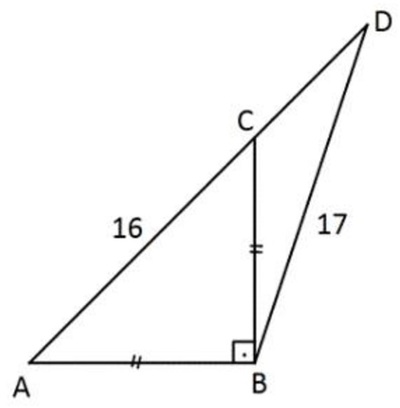Find cd

△ A B C has A B = B C , A C = 1 6 , and ∠ B = 9 0 ∘ . A C is extended to D such that B D = 1 7 . Find the length of C D .
The answer is 7.
This section requires Javascript.
You are seeing this because something didn't load right. We suggest you, (a) try
refreshing the page, (b) enabling javascript if it is disabled on your browser and,
finally, (c)
loading the
non-javascript version of this page
. We're sorry about the hassle.
3 solutions
Let x = A B = B C , then
1 6 = x 2
x = 2 1 6
Apply Sine Law on △ C D B
2 1 6 sin ∠ C D B = 1 7 sin 1 3 5
∠ C D B = 2 8 . 0 7 ∘
a n g l e C B D = 1 8 0 − 1 3 5 − 2 8 . 0 7 = 1 6 . 9 3 ∘
Apply Sine Law on △ C D B again,
sin 1 6 . 9 3 C D = sin 1 3 5 1 7
C D = 7 units
B C = 8 2 ∠ A C B = 4 5 ° ⇒ ∠ B C D = 1 3 5 °
Let C D = x
Applying cosine formula in △ B C D
1 7 2 = ( 8 2 ) 2 + x 2 − 2 ⋅ ( 8 2 ) x cos 1 3 5 ° ⇒ 2 8 9 − 1 2 8 = x 2 + 1 6 x ⇒ x 2 + 1 6 x − 1 6 1 = 0 ⇒ ( x − 7 ) ( x + 2 3 ) = 0 Taking positive value of x .
C D = x = 7
Extend A B to E such that ∠ D E A = 9 0 ∘ . Since △ A B C is a right isosceles triangle, ∠ A = 4 5 ∘ . Let C D = x . Then A E = D E = 2 1 6 + x and B E = 2 x . By Pythagorean theorem, we have:
B E 2 + D E 2 2 x 2 + 2 ( 1 6 + x ) 2 x 2 + x 2 + 3 2 x + 2 5 6 x 2 + 1 6 x − 1 6 1 ( x − 7 ) ( x + 2 3 ) x = B D 2 = 1 7 2 = 5 7 8 = 0 = 0 = 7 Since x > 0